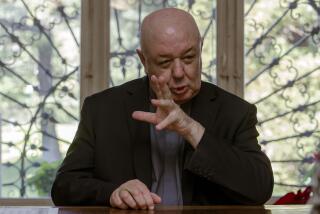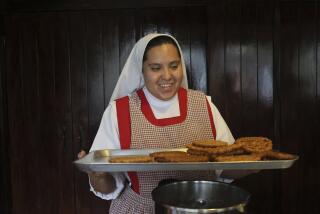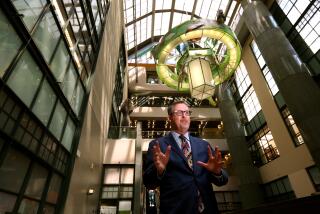Saving a treasured trove, ever so slowly
- Share via
SINAI, EGYPT — On a refreshingly cool morning, before the sun drenches every exposed grain of sand in this vast desert, Hemeid Sobhy sets out on foot from the Bedouin village where he lives with his parents and sisters. Neatly dressed in jeans, sport shirt and sturdy sandals, he walks 40 minutes to the Holy Monastery of St. Catherine.
He passes through a narrow door in the monastery’s thick walls and makes his way past an ancient church and a warren of buildings, clustered along winding pathways. A stairway takes him to the third floor of a relatively modern structure along the monastery’s south wall, where he enters the library, greets a monk in a long black robe and gets to work.
His office is an 8-foot-square, 8-foot-tall tent of clear plastic sheeting stretched over a metal frame. A filtering system keeps the air free from dust. Erected in a small room at the end of the cavernous library, the tent is equipped with a computer, a large-format digital camera, two flash units on tripods and a metal cradle designed to hold fragile manuscripts safely in place while they are photographed.
The setup could hardly seem more out of place at the oldest continuously operating monastery in Christendom. But St. Catherine’s is entering the Age of Technology -- with the help of Father Justin Sinaites, a 57-year-old American monk from El Paso, and Hemeid, the 23-year-old son of a Bedouin camel driver. They are implementing a digital photography project that will make high-resolution images of the library’s closely guarded manuscripts available to scholars all over the world.
Consisting of 3,300 manuscripts in 11 languages -- many of them richly illuminated in gold leaf and bright, jewel-like colors -- the library’s collection is second in number and importance only to the trove at the Vatican. With manuscripts made as early as the 6th century, the Sinai cache consists mainly of scriptures, sermons and texts for religious services, but it includes classical Greek literature and a few medical texts with herbal remedies for various afflictions.
Today the object awaiting its close-up is a rare Arabic manuscript of Christian gospels, written on parchment in 897. A vacuum hose attached to the cradle gently pulls back the open page. A narrow piece of bone placed on the front of the page, near the binding, helps to flatten the rumpled parchment.
Hemeid scrutinizes a video preview of the page on the computer screen, centers the image, adjusts the focus and clicks the mouse. The flash units, covered with diffusers to remove harmful ultraviolet light, pop four times as the camera takes four pictures, each in a slightly different position. Hemeid clicks a command that enables the computer to merge the four exposures into a single high-resolution digital photograph.
One more page down; hundreds of thousands to go.
“If you do the math, it’s discouraging,” says Father Justin, who oversees the library. “There are 1.8 million pages, not to mention the manuscript fragments discovered in 1975, known as the New Finds; the scrolls and the collection of early printed books -- all in overwhelming numbers. But each manuscript is the work of a patient scribe working with difficult materials, recording a text of importance. Each manuscript is unique, and each is yet another facet of the library of Sinai, contributing to our understanding of the spiritual heritage that has been preserved here.”
Protection in isolation
Lodged in a fortress-like complex at the foot of precipitous mountains on a forbidding desert, St. Catherine’s has survived partly because of its isolated location. The difficulty of getting here, even now that paved roads bring busloads of tourists, has protected the monastery and its spectacular collections of manuscripts and Byzantine icons, examples of which are on view through March 4 in a landmark exhibition at the J. Paul Getty Museum in Los Angeles.
But remotely situated as it is, the monastery is a Greek Orthodox oasis in Muslim territory. St. Catherine’s resides in a community that is also adjusting to modernity.
When Byzantine Emperor Justinian built the monastery, in the 6th century, he moved about 200 families of Bedouin slaves from Alexandria and the northern shore of Anatolia to guard and care for it. Today their descendants, the Jebeliya tribe of Sinai Bedouins, who are Muslims, offer camel rides to visitors making the trek up Mt. Sinai and provide the monastery with an essential workforce. As the resident population of monks at St. Catherine’s has dwindled to 25, Bedouins have continued to serve as guards, cooks, gardeners, restaurant managers, storeroom supervisors and shopkeepers. Their wages are low but so are living expenses in Sinai, Father Justin says.
Hemeid’s father, Sobhy Hemeid, worked at the monastery’s pharmacy until 1986, when he became a camel driver. The young man’s grandfather was employed at St. Catherine’s for 50 years, and many of his relatives still tend the bookshop, but he headed off to college in Cairo. Overwhelmed by the city’s noise, confusion and pollution, he transferred to a university in much quieter Ismailiya, where he studied accounting, economics, management and computer science, and graduated in June 2005.
“When I was studying at the university, the archbishop said I could work at the monastery,” Hemeid says in carefully considered English. He had thought he might work in a bank, but when he didn’t find a situation that suited him, he went home and presented himself to Archbishop Damianos. As abbot of St. Catherine’s community of monks, the archbishop is responsible for day-to-day operations and outreach as well spiritual traditions.
Hemeid’s timing was impeccable. Father Justin, who arrived at the monastery in 1996, needed help. Born into a Baptist family that published religious books, he became fascinated with Byzantine history as a student at the University of Texas and joined the Greek Orthodox church. He entered a monastery in Brookline, Mass., and took charge of its publishing projects.
At St. Catherine’s, he started making digital images of the manuscripts when he was second in command at the library. Saint Catherine Foundation, a London-based charitable organization devoted to supporting the library, had allotted $10,000 to the project. Larger grants from other sources had paid for necessary equipment. The Flora Family Foundation in Menlo Park, Calif., gave $150,000; Italian publishing heir Leonardo Mondadori donated $35,000.
But after photographing some of the most important manuscripts, Father Justin was promoted. New responsibilities left little time to continue the project. He had to facilitate plans to renovate the library and conserve its collections. On the rare occasions when manuscripts from the collection are allowed to travel, he accompanies them. And he is in demand as a speaker. He will present a seminar on one of the manuscripts in the Los Angeles exhibition Tuesday at the Getty Center. (getty.edu/art/exhibitions/icons_sinai/events.html)
“When I asked for a helper, the monks’ first instinct was to bring people from Greece because they know them, they trust them, they share the same culture,” says Father Justin, adding that he and a British colleague are the only monks at the monastery who are not Greek. “But then you have the expense of transportation, wages, room and board. And how long can you expect the person to be here? So I told them, ‘Get me a Bedouin who is instinctively careful and I can teach him the computer part.’ They live here, we have known all their relatives for generations, and there is no thought about how long they can stay here.”
When Hemeid applied for work at the monastery, he knew nothing about the library.
“I did not decide to work there,” he says. “The Archbishop chose that place for me.”
A quiet trailblazer who spends his spare time listening to Arabic music while working on his home computer, Hemeid has the dreams of many young men. He wants to get married and have a child. He hopes to have a car. But he is the first person in his community to graduate from a university and the first Bedouin to secure such a rarefied position at the monastery.
By all accounts, he caught on quickly because of his experience with computers.
“He is a tremendous help,” Father Justin says. “He is very careful. When he sees something that is not quite right, he asks me, instead of just charging ahead. That’s exactly what I want. Each manuscript is unique and presents its own demands. But there is a certain repetition once things are set up. I compare it to driving. You have to be alert, but there’s a routine to it. I think it takes a certain temperament. I think Hemeid has it.”
Six months into his job, Hemeid seems to have found a niche. He has no plans to leave the monastery or his village.
“I am so happy to have this job,” he says. “I feel that I have important work. I love it so much that I never get bored.”
He isn’t likely to run out of work, even if the project is narrowed down considerably.
“Photographing the whole library is not a realistic goal,” Father Justin says. “But, as with all collections, 90% of the users are interested in 10% of the collection. The 10% that is of the greatest interest is quite a reasonable goal.”


